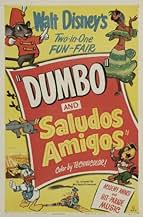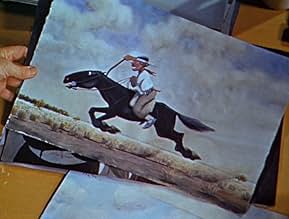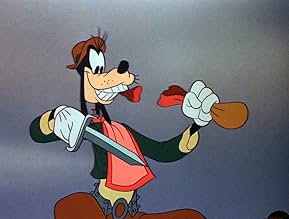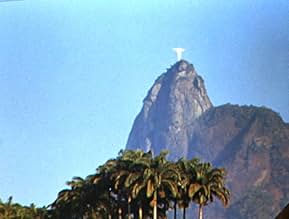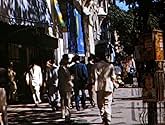IMDb RATING
6.0/10
8.6K
YOUR RATING
Disney animators tour South America and present four animated shorts inspired by their trip.Disney animators tour South America and present four animated shorts inspired by their trip.Disney animators tour South America and present four animated shorts inspired by their trip.
- Nominated for 3 Oscars
- 1 win & 3 nominations total
Fred Shields
- Narrator
- (voice)
Mary Blair
- Self
- (uncredited)
Stuart Buchanan
- Flight Attendant
- (voice)
- (uncredited)
Pinto Colvig
- Goofy
- (voice)
- (uncredited)
Walt Disney
- Walt Disney
- (uncredited)
Norman Ferguson
- Self
- (uncredited)
Frank Graham
- Self
- (uncredited)
Clarence Nash
- Donald Duck
- (voice)
- (uncredited)
Frank Thomas
- Self
- (uncredited)
Featured reviews
A fairly ordinary Disney travelogue cartoon. Ironically, the live action sequences are more interesting than the cartoons, although Goofy's turn is actually quite informative.
This more than any other film shows the plight of the Disney studio in the years following "Snow White" and "Pinocchio".
WWII had broken out, cutting off Disney's European market. In addition, striking cartoonists and their formation of a guild/union meant that the massive about of labor needed to create a "Snow White" or a "Pinocchio" now amounted to a substantially higher production cost then either of those two films (which had not been cheap to begin with).
Thus, Disney was trying to explore new ways to both package his product for another market, as well as develop new product.
They released this movie and capitalized on the then-popular South American craze. Now, however, it looks dated.
You can still it watch it though and see the genesis for several of Disney's later films: "The Three Caballeros" and the whole "How-To" Goofy series are the most obvious.
WWII had broken out, cutting off Disney's European market. In addition, striking cartoonists and their formation of a guild/union meant that the massive about of labor needed to create a "Snow White" or a "Pinocchio" now amounted to a substantially higher production cost then either of those two films (which had not been cheap to begin with).
Thus, Disney was trying to explore new ways to both package his product for another market, as well as develop new product.
They released this movie and capitalized on the then-popular South American craze. Now, however, it looks dated.
You can still it watch it though and see the genesis for several of Disney's later films: "The Three Caballeros" and the whole "How-To" Goofy series are the most obvious.
When I first heard that Disney was going to release a number of films from the early years which had been "almost forgotten," I was very intrigued. Would there be another Sleeping Beauty or Fantasia hiding out there?
Sadly, Saludos Amigos falls very short of "Disney classic" status. It is basically forgettable.
There are a few smile-inducing moments, but overall the piece really does feel like a "keep the Sudamericanos on our side against the Nazis" period piece from the WW2 era. It's strange to watch a movie made in 1943 with live action sequences of South America looking so peaceful and unaffected by the world's events. Sure, the region was less involved in WW2 than many other regions... but, it is still strange to watch.
Anyway, I'd sum it up thusly: 1. Worth buying if you are a Disney collector and 2. Worthy of note simply to see live shots of Buenos Aires, Lago Titicaca, and Rio de Janeiro, filmed almost 60 years ago.
Other than that, you can skip this one.
Sadly, Saludos Amigos falls very short of "Disney classic" status. It is basically forgettable.
There are a few smile-inducing moments, but overall the piece really does feel like a "keep the Sudamericanos on our side against the Nazis" period piece from the WW2 era. It's strange to watch a movie made in 1943 with live action sequences of South America looking so peaceful and unaffected by the world's events. Sure, the region was less involved in WW2 than many other regions... but, it is still strange to watch.
Anyway, I'd sum it up thusly: 1. Worth buying if you are a Disney collector and 2. Worthy of note simply to see live shots of Buenos Aires, Lago Titicaca, and Rio de Janeiro, filmed almost 60 years ago.
Other than that, you can skip this one.
A "package film" wherein Walt Disney and his team of animators, artists, and musicians travel across South America experiencing various geographical and cultural points of interest which lead into 4 animated shorts inspired by their visits.
Following the underperformance of Disney's animated films Pinocchio, Fantasia, and Bambi as a result of World War II cutting off needed European and Asian markets, Saludos Amigos came from a State Department arranged "goodwill tour" for Disney and his team as part of the Good Neighbors Policy to improve relations between neighboring South American countries whom had diplomatic and commercial ties to Axis powers such as Nazi Germany. Looking to recoup losses on his overexpanded studio as well as his commercial failures, Disney accepted the deal with the federal grants helping ot finance the film which proved to be a strong success. While the movie is certainly a curiosity with some good animation, it's honestly not all that much of a "movie" with only a 40 minute runtime with a collection of animated shorts that are serviceable but don't exactly stand out much from the usual Silly Symphonies Disney put out saved for the novelty of South American cultural and geographical Iconography that when coupled with the rather dry documentary footage makes the film feel rather anemic.
The animation par for the course for Disney animation is good (though admittedly it's not as ambitious as Disney's other feature films including Dumbo which while intentionally cheap was at least experimental with certain elements). The film features three shorts, two featuring Donald Duck, one featuring Goofy, and another featuring an anthropomorphic plane named Pedro. The Donald Duck short Lake Titicaca, and the Goofy short El Gaucho Goofy are showcases for some entertaining slapstick (with a suspension bridge sequence with Donald Duck being particularly humorous) and while not being anything groundbreaking they are at least enjoyable enough. Pedro is probably the weakest short as it's basically just a cutesy story with a young plane going over mountains to deliver mail over the Andes mountains. It's animated well enough and you can see some of the artistic staples that would be reutilized for later era Disney shorts like Susie, The Little Blue Coupe or The Little House but other than that it's pleasant but forgettable. The final short, Watercolor of Brazil is definitely the most ambitious of the shorts as we start with a bank canvas that is then brough to life through a paint brush giving us the various flora and fauna of Brazil with good usage of misdirection with some memorable moments being a bunch of bananas that turns into Toucans or a tree that turns into a Macaw. This short also marks the first appearance of José Carioca the parrot who along with Donald Duck shows him some of Brazil and the "spirit of the Samba" and with his dapper appearance and energy makes a welcome addition to the Disney canon.
Saludos Amigos is certainly an important piece of Disney history and you can't argue against the role it played in keeping Disney studios afloat during trying times and giving Disney a tangible foot print in South America as well as changing U. S. public perceptions of South America with its travelogue approach. But as a movie its very thin and while its animation is good by the standards of Silly Symphonies nothing except maybe Watercolor of Brazil elevates it beyond the typical short. Worth a watch for curiosity's sake, but one of the weaker parts of the Disney animated films.
Following the underperformance of Disney's animated films Pinocchio, Fantasia, and Bambi as a result of World War II cutting off needed European and Asian markets, Saludos Amigos came from a State Department arranged "goodwill tour" for Disney and his team as part of the Good Neighbors Policy to improve relations between neighboring South American countries whom had diplomatic and commercial ties to Axis powers such as Nazi Germany. Looking to recoup losses on his overexpanded studio as well as his commercial failures, Disney accepted the deal with the federal grants helping ot finance the film which proved to be a strong success. While the movie is certainly a curiosity with some good animation, it's honestly not all that much of a "movie" with only a 40 minute runtime with a collection of animated shorts that are serviceable but don't exactly stand out much from the usual Silly Symphonies Disney put out saved for the novelty of South American cultural and geographical Iconography that when coupled with the rather dry documentary footage makes the film feel rather anemic.
The animation par for the course for Disney animation is good (though admittedly it's not as ambitious as Disney's other feature films including Dumbo which while intentionally cheap was at least experimental with certain elements). The film features three shorts, two featuring Donald Duck, one featuring Goofy, and another featuring an anthropomorphic plane named Pedro. The Donald Duck short Lake Titicaca, and the Goofy short El Gaucho Goofy are showcases for some entertaining slapstick (with a suspension bridge sequence with Donald Duck being particularly humorous) and while not being anything groundbreaking they are at least enjoyable enough. Pedro is probably the weakest short as it's basically just a cutesy story with a young plane going over mountains to deliver mail over the Andes mountains. It's animated well enough and you can see some of the artistic staples that would be reutilized for later era Disney shorts like Susie, The Little Blue Coupe or The Little House but other than that it's pleasant but forgettable. The final short, Watercolor of Brazil is definitely the most ambitious of the shorts as we start with a bank canvas that is then brough to life through a paint brush giving us the various flora and fauna of Brazil with good usage of misdirection with some memorable moments being a bunch of bananas that turns into Toucans or a tree that turns into a Macaw. This short also marks the first appearance of José Carioca the parrot who along with Donald Duck shows him some of Brazil and the "spirit of the Samba" and with his dapper appearance and energy makes a welcome addition to the Disney canon.
Saludos Amigos is certainly an important piece of Disney history and you can't argue against the role it played in keeping Disney studios afloat during trying times and giving Disney a tangible foot print in South America as well as changing U. S. public perceptions of South America with its travelogue approach. But as a movie its very thin and while its animation is good by the standards of Silly Symphonies nothing except maybe Watercolor of Brazil elevates it beyond the typical short. Worth a watch for curiosity's sake, but one of the weaker parts of the Disney animated films.
I think the reviews of the other posters has been pretty accurate. It is very nice in the era of pixar to see the lush animation of Disney. The special feature South of the Border is fascinating. I hope these Disney travelogues are preserved and digitally enhanced because it would be a great shame to lose them. The picture quality is poor but it is better than not having any recollection at all. The narration is pure Disney and its all about the research that went into the main feature. Of course its testimony to history that seen through the eyes of middle upper class Americans its not really as accurate as Walt thought it was. Some of the facts are not facts at all. They call one creature a rabbit in the documentary but its certainly not a rabbit. It is a capybara. In the cartoon they even have an ostrich in South America!! Still despite the flaws the documentary is a charming bonus with some nostalgic images. Saludos is a pretty good cartoon although I thought the little aeroplane story was quaint it is anthromorphism gone crazy. Everyone's favourite duck with a speech impediment is fun. I never understood a word Donald said but loved his attitude. Goofy steals the movie. It took me years to realise Goofy was a dog! Its a pleasant Disney movie while not being a great one.
Did you know
- TriviaThis movie and Les Trois Caballeros (1944) were created by Disney in order to improve the United States of America's relations with South American countries during World War II.
- Crazy creditsWith sincere appreciation for the courtesy and cooperation shown us by the artists, musicians and our many friends in Latin America - (signed) Walt Disney
- Alternate versionsThe initial DVD release removes a scene where Goofy is seen smoking a cigarette and blowing smoke rings. It was finally released completely uncensored for historical purposes on the Blu-ray release and as a bonus on the DVD release of Walt & El Grupo (2008). (Uncensored, but not the original version: on the Grupo DVD the RKO distribution card which dissolves into the Disney card has been replaced with the later Buena Vista distribution card, which fades to black and then the Disney card a little later than the dissolve. It's also in 5.1 sound instead of mono. On the Blu-ray release, neither the RKO distribution card nor the later Buena Vista distribution card wasn't used at all and just began with the Disney card.) The collector's edition laserdisc is uncensored with the original logos and mono sound.
- ConnectionsEdited from Le lac Titicaca (1942)
- What are the differences between the old VHS Versions and the DVD Versions?
Details
- Runtime42 minutes
- Aspect ratio
- 1.37 : 1
Contribute to this page
Suggest an edit or add missing content








